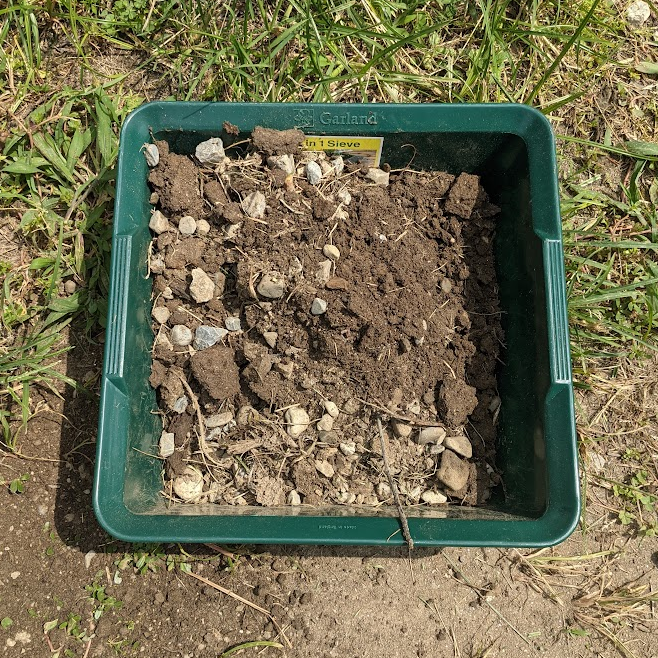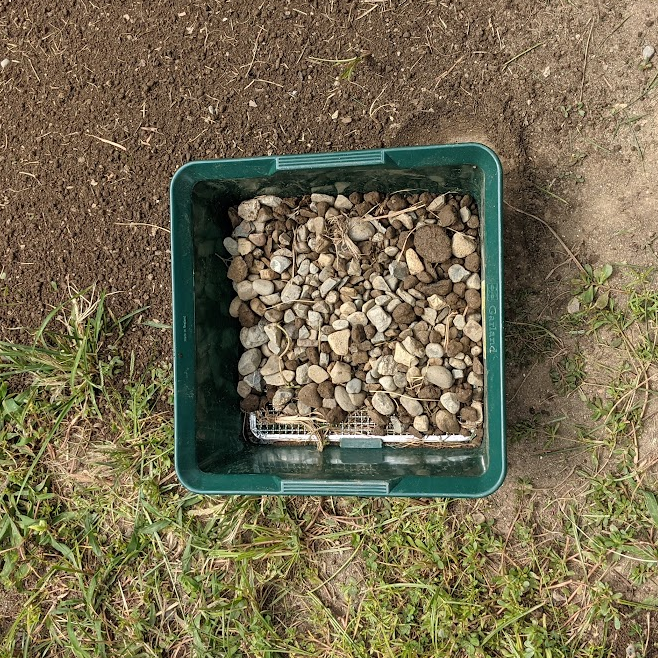About a year, maybe less, before it was sold to us, our backyard underwent an overhaul. Much of the apparently very expensive lawn was torn out and replaced with rocks. But crucially, not all of it. The rocks were a large rectangular footprint in the middle of a framing strip of grass on all sides, the perfect size to make maintenance challenging if not impossible. In addition, there was ivy underneath the deck steps growing over woodchips, flat cement and pads of bricks in adjacent places, a different kind of smaller smoother pebbly rocks next to that. A different kind of ivy along the back fence, sometimes climbing five hedge-like trees. And big beautiful bulb-based flowers sprouting up through the lawn that I think must have been a sale-only innovation.
In short, it looked like a demonstration project from a landscaper. Here are seven different ways of covering your yard space to compare against each other.
This is how it was marketed:

Pretty early on, we decided we didn’t want the rocks. It’s not that the rocks were innately terrible, but they paired very poorly with the little strip of green around them, and they’re particularly unappealing for a toddler. Rocks can be a nice little touch in places here and there as an accent, but in this quantity, it made the yard feel more like a driveway, or the lonely right field I poorly patrolled in my first Little League season. So, we undertook getting rid of the rocks.
Alex posted them on Facebook marketplace. Free rocks, she offered. Free? people asked. Free, she confirmed. All you have to do is haul them away yourself. We’ll provide a shovel.
This was in late spring. For weeks, we hosted an assortment of neighbors and even hour-long travelers, come to haul out some free rocks. There were several skeptics: “Why are you getting rid of the rocks?” they would eye me warily. “Is something wrong with them?” I would shrug at them blankly. “Nope, just didn’t want them. They’re just rocks.” They’ve been bathed in radiation and you are part of an experiment, I darkly considered saying. Why else would anyone on the east coast give anything away for free?
Some people wouldn’t take free for an answer. One guy brought a helper with several large bags, we got to chatting, and he literally stuffed a bill in my pocket and then fleetly sprinted to his truck while I protested. I was horrified that it was a twenty, but simply appalled when I pulled it out and it was a fifty. He yelled out the truck window that he would have had to pay a landscaper several times that for a comparable quantity.
People showed up with one small Target bag. They showed up with a small bucket. They showed up with no containers at all and asked to borrow something. They showed up with their own shovels and large contractor bags. They showed up with containers, filled them, found them to be vastly too heavy, and dumped most of the contents. They showed up once, left, and returned with friends. Sometimes again. And again.
Finally, with seemingly very little progress underway despite a steady stream of takers, one guy showed up with an industrial conveyor system of huge buckets in the back of a truck, smaller buckets to haul them out of the yard and into those buckets, his own shovel, and apparently hours to spare. My instinct was that he was reselling them, but this is probably just me being hardened by 2+ years on the east coast myself, to go with the decade prior of living out here. The guy was, frankly, a bit strange and gruff and businesslike and he spent hours and hours in our yard. But… he took almost all the remaining rocks. And then he came back and got us very close to cleaned out.
But not, as it turns out, all the way there. And therein lies the rub. For what remained was a seemingly intractable few buckets worth, much of it well imbedded among the underlying dirt. (There had been a vaguely ineffectual plastic liner underneath the rocks, through which plenty of weeds still grew, and by the time the guy had left us with few rocks, the liner was pretty well torn up anyway. That said, we definitely made the rock/dirt integration problem worse in our haste to actually remove the liner.)
It’s been months. Our planter box that we so carefully selected and filled with cauliflower and broccoli, getting Graham’s help and excitement, then tended to for weeks, overgrew and then was overtaken by clinging vines and weeds. The plums fell everywhere, leaving half-eaten remnants for ants, flies, bees, and squirrels to fight over, eventually yielding just hard ovular pits. Grass grew and overgrew. Weeds took over the dirt rectangle, obscuring little patches of remaining rocks. The actual remaining rock piles became like little mountains, changing the yard’s topography. In short, nature and decay, flush with summer’s vibrant energy, took over.
Yesterday, I made another run at fighting back. We’d already bagged up several Target bags of rock and dirt, though I still am unsure if these are viable candidates for trash pickup and am having a hard time getting over the notion that it’s a colossal waste to dispose of them this way. There’s a dump available somewhere, but in the weird nature of these things, I think we would have to pay them to accept our heavy load of recalcitrant rocks. What remains is not really clean enough for others to use, unless they want weed bits and plenty of dirt. And this last bit got me thinking: What if we sifted the rocks?
Alex was skeptical, seeing this as an overly laborious process for not much marginal reward. And it turns out that she was completely right in this assessment. When I finally got out yesterday in the humid high eighties, I found my progress laughably slow and was even beset by occasional collapses of my $30 Amazon sifter. I found a better groove over time in realizing that, of course, less is more and that the cubic volume of the sifter is an aesthetic leverage proportion and by no means a recommended serving size of manageable dirt if filled. The shaking process, while awkward and neck-straining at first, did seem vaguely yogic in the muscles it activated. Muscles long neglected from three years with almost no athletic activity.

The process was painstaking and demoralizing and yet, in the doing, I didn’t feel that way. I felt energized and rejuvenated. I felt days of deep-seated depression recede just slightly. It didn’t lift, the fog didn’t evaporate, but it cleared in a way that allowed me to see through it, just a touch. In short, the endorphins of physical release, of doing hard repetitive exercise in an unrelenting outdoor environment did all the things people annoyingly say it will. It made me feel better.

I was drawn again to revisiting what it was that my father found so satisfying about outdoor labor, taking me all the way back to the beginning of this project. Yes, he loved improving things and the feeling of a job well done. He enjoyed enacting his vision for things on his little corner of the world, the satisfaction of feeling control over an environment. But I wonder, sometimes, how much of it was just an attachment to the natural positive feedback loop our physical body manifests for the right kind of exertion? Was he more or less addicted to exercise? He was such a physical, bodily person, far more attuned to the impacts of food and space and the corporeal than I ever have been. Maybe to get through his death, I need to tap into more of what made him so capable in life.

I think this project is creating an illusion. By its nature, by design, it follows a narrative flow by which I take a step forward most days and, in so doing, create improvement. I make a little part of my world or my life better and, in sequence, gradually make everything more okay. Fake it till you make it, I remember as frequently proffered and often taken and yes, even good advice in 2010. We can change our minds with a matter of perspective. If we think that we are making progress, that can be a form of progress in itself.
But I am not okay. I am not getting better. Things feel, on a minute by minute basis, almost impossible. I am straining and tearing at the edges of what I can do. I want to be very clear. I am in crisis. I do not feel like I have the help and support I need to get through this. I like playing ball with the moments that feel exceptional to this, I like highlighting them and illustrating them as an exercise to show me what could be. But I don’t want to give you the wrong impression. It’s not working. Or not enough, not yet. And I don’t know what to do.
This is the 17th post in the One Thing series.
Last Five
#16: Fifteen Nails
#15: Old Friends
#14: Mailing it in
#13: Get Organized
#12: That Escalated Quickly
Introduction & First Four
#4: Forgive, Don’t Forget
#3: Call Your Mother
#2: In the Land of Make-Believe
#1: Wistful Wisteria
Introduction: Announcement and Rules


